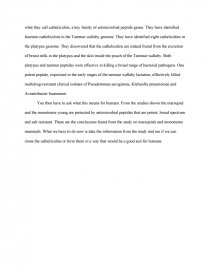Cell Parts and Their Functions
Essay by Woxman • April 2, 2012 • Essay • 526 Words (3 Pages) • 1,774 Views
Antibiotics are something we as a species use quite commonly. If you have an ear infection, strep throat, a urinary tract infection, or other infections then you take an antibiotic for them in order to treat them. Now we have to worry about our bodies becoming resistant to antibiotics. We have been using antibiotics for a long time now and the more that we use antibiotics the more our bodies become resistant to the antibiotics that we have available on the market for use.
First we should know what an antibiotic is. An antibiotic is a drug that kills or slows the growth of bacteria. Antibiotics are one class of "antimicrobials", a larger group which also includes anti-viral, anti-fungal, and anti-parasitic drugs. They are relatively harmless to the host, and therefore can be used to treat infection. We have to find a way in order to protect ourselves against these bacterial infections. To overcome the increasing resistance of pathogens to existing antibiotics the 10×'20 Initiative declared the urgent need for a global commitment to develop 10 new antimicrobial drugs by the year 2020. What they are talking about is looking at some of our distant animal descendants to see what they might have to offer humans as far as natural antibodies that we can form into antimicrobial drugs for ourselves.
Scientists have been looking at different species like the Tammar wallaby, the platypus, and marsupial's antimicrobials to see how we can use them for the human population. They see marsupials as a good source because their young are grown prematurely outside of a protective pouch rather than a womb inside the body. They've studied how the young become resistant to the bacteria that surround them. Some of it comes from the mother's milk. It is like how a human mother breast feeds her child and what the mother ingests, plus her own antibodies, are transported from mother to child via lactation. It is the same way with the platypus.
When scientists look into what it is that is helping these young survive they are finding what they call cathelicidins, a key family of antimicrobial peptide genes. They have identified fourteen cathelicidins in the Tammar wallaby genome. They have identified eight cathelicidins in the platypus genome. They discovered that the cathelicidins are indeed found from the excretion of breast milk in the platypus and the skin inside the pouch of the Tammar wallaby. Both platypus and tammar peptides were effective in killing a broad range of bacterial pathogens. One potent peptide, expressed in the early stages of the tammar wallaby lactation, effectively killed multidrug-resistant clinical isolates of Pseudomonas aeruginosa, Klebsiella pneumoniae and Acinetobacter baumannii.
You then have to ask what this means for humans. From the studies shown the marsupial and the monotreme young are protected by antimicrobial peptides that are potent, broad spectrum and salt resistant.
...
...

